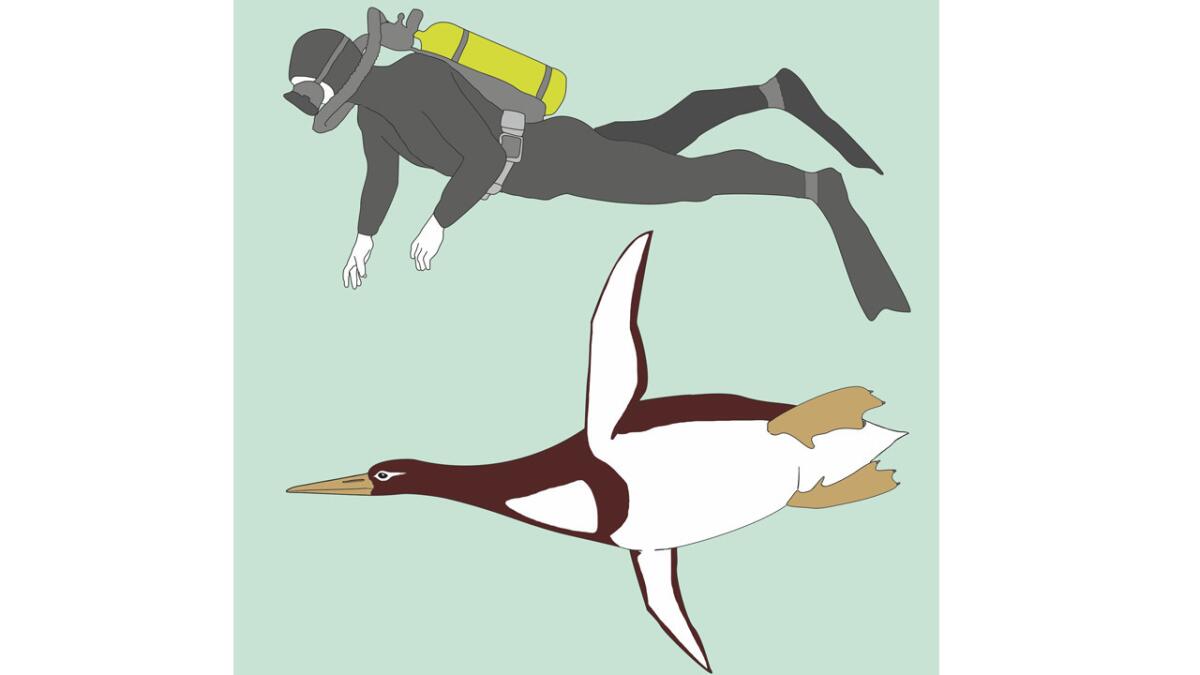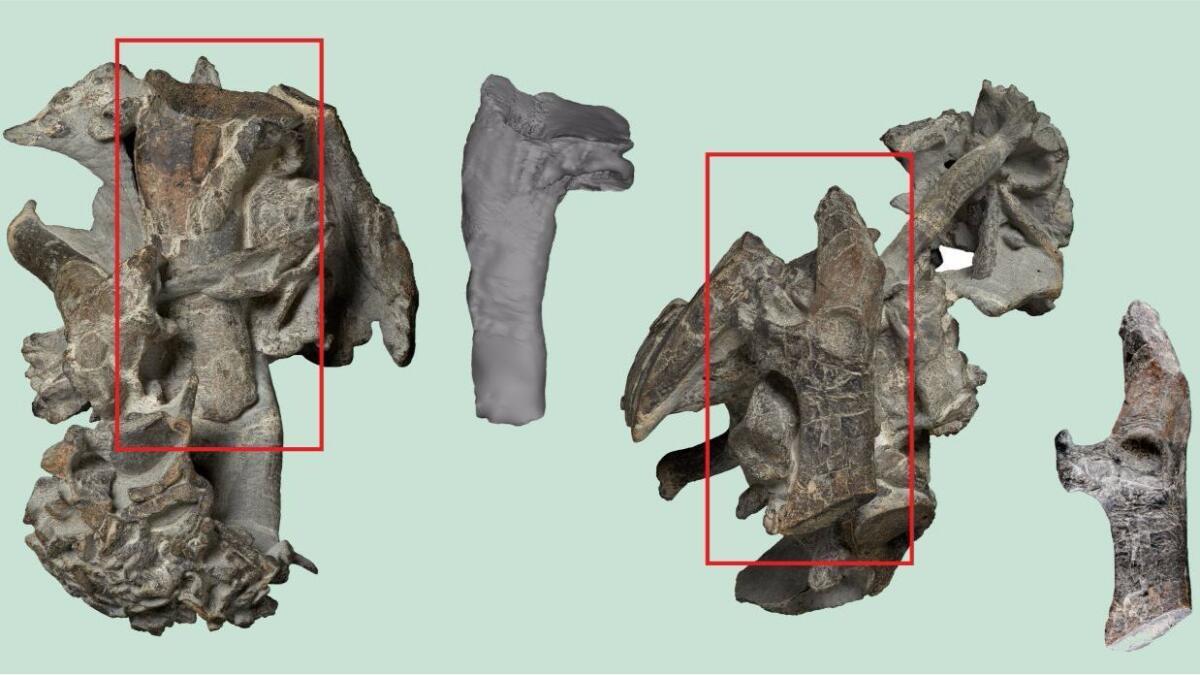Giant penguins, as tall as people, lived in New Zealand millions of years ago

- Share via
Scientists have discovered the fossil remains of an ancient giant penguin with a body length of about 5.8 feet that roamed the waters off New Zealand soon after the dinosaurs’ demise.
Kumimanu biceae, newly described in the journal Nature Communications, is one of the oldest penguin species found yet – and it adds a surprising twist to what researchers thought they knew about penguin evolution.
The K. biceae bones were discovered on a beach in New Zealand many years ago, embedded in rock, so obscured that at first the scientists thought they had belonged to a turtle, said lead author Gerald Mayr, an ornithologist at Senckenberg Research Institute and Natural History Museum Frankfurt in Germany.
They painstakingly cleared rock away from the bones, revealing that the fossil was actually of an enormous penguin — roughly 1½ times the size of the emperor penguin, the largest living species today. At about 223 pounds and 5 feet, 9 inches in body length, K. biceae was the size of a human man.
“I was amazed at how big it actually was,” said Mayr, whose co-authors in New Zealand brought him in to examine the fossil.
K. biceae was dated to 55.5 million to 59.5 million years ago, which puts it in the Paleocene epoch. Back then it was so warm that even Antarctica hosted subtropical waters; in New Zealand, the birds probably dined on fish as they do today, but may have speared them with long beaks.
The strangest thing about these penguins was not just their size, although that is pretty exceptional. What caught researchers’ eye was how old they were — how early they appeared in the penguin family tree.
There have been plenty of other oversized penguins in the fossil record, but those species came tens of millions of years later, leading many researchers to figure that it probably took time for penguins to evolve into megafaunal species.
This new fossil shows that penguins had grown to enormous proportions very quickly after the dinosaurs were killed off around 66 million years ago. On top of that, K. biceae seems to have more primitive features than those later large penguins, and it appears to have developed into a large species independently of the others.
(While there has been some previous evidence of a penguin species from Antarctica that may even have topped K. biceae, it was not nearly as complete as the New Zealand species and so it’s difficult to accurately extrapolate its overall size, Mayr said.)
That time frame – penguins’ ancestors losing flight and gaining the ability to swim, and then getting very, very big, all in about 5 million years – seems really, really fast, the scientists said.
It could potentially mean that the flying ancestors of penguins coexisted with dinosaurs for a good long while before the asteroid wiped them out, though that’s just a hypothesis for now, Mayr said. (It should be noted, by the way, that those pre-penguins were themselves descended from dinosaurs.)

Aside from the speed with which it seems to have happened, this super-sizing is to be expected, the ornithologist said.
“That’s something we see in flightless birds in general, that they tend to become very large once they lose their flight capabilities and once aerodynamic constraints cease to exist,” Mayr pointed out.
After all, once you don’t have to spend the energy to get airborne, you don’t have to watch your weight as closely. (Take ostriches, for example.) And there are certain advantages to going up a few sizes: you can muscle out the competition for food or territory, and you might be much harder for predators to kill.
“It’s not that surprising that those giant penguins were so large,” Mayr said. “But it’s rather surprising that there are no giant penguins any more today.”
So what happened to these feathered heavyweights?
That disappearance may have something to do with the rise of marine mammals such as seals and toothed whales, Mayr said. As they began to flourish in the fossil record, those big-boned ocean birds started fading out.
It’s unclear whether there’s a causal relationship there, and if so, what one would be, Mayr said. Perhaps marine mammals competed with large penguins for food, or (in the case of seals) for breeding grounds. Perhaps they actually hunted the jumbo penguins.
For now, this is just one specimen. Scientists hope to find more of them, especially with their skulls and beaks intact. There were also plenty of smaller penguins that appear to have coexisted with this giant penguin, and it’s unclear exactly what the relationships were between those species.
“We hope there will be future finds,” Mayr said. “There are many questions.”
Follow @aminawrite on Twitter for more science news and “like” Los Angeles Times Science & Health on Facebook.
MORE IN SCIENCE
Is ‘man flu’ real? Medical science delivers comfort to helpless male snufflers
Cassini may be dead, but a new era of Saturn science has just begun
In the face of a threat, narwhals respond in just about the worst possible way




